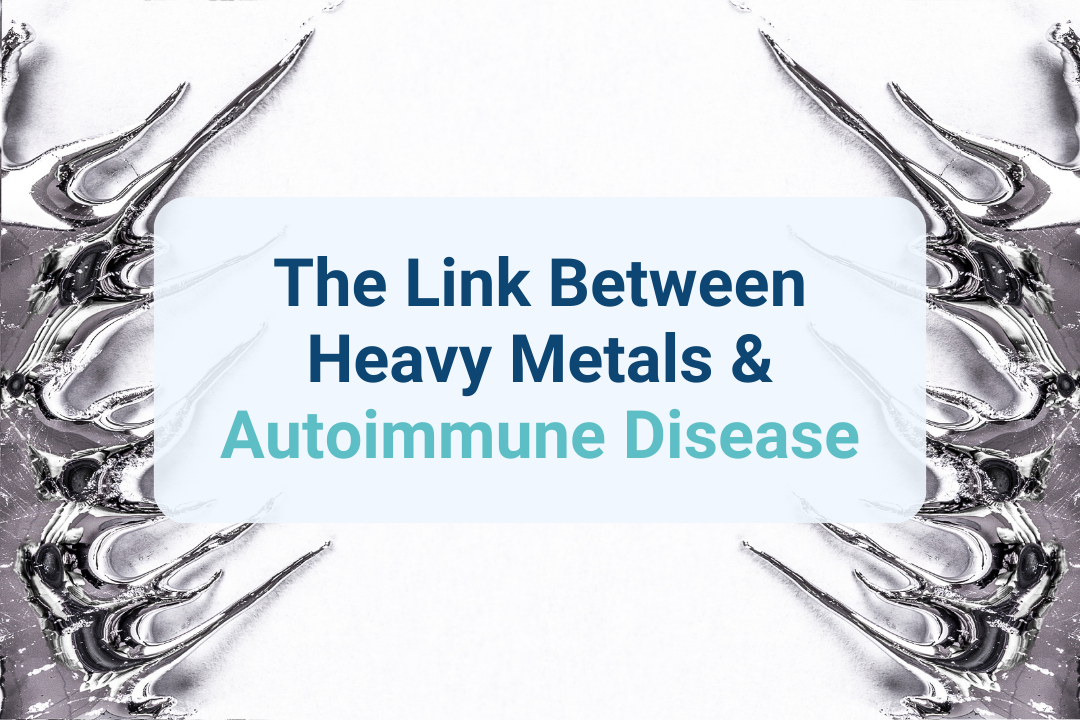The Connection Between Toxins and Pediatric Depression: A Functional Medicine Approach
With pediatric depression on the rise, it’s more important than ever to take a thoughtful, proactive approach to supporting children’s mental health.
In 2020, 2.4 million children were diagnosed with depression, and the numbers have only worsened. Researchers from the Health Resources and Services Administration found that anxiety and depression among children ages 3-17 has greatly increased over the last five years. Yet despite this growing crisis, 1 in 5 children who need mental health support never receive the care they deserve.1

The conventional model for treating childhood depression tends to focus on symptom management rather than root-cause resolution. Traditional approaches often only target neurotransmitter imbalances while overlooking critical environmental, physiological, and lifestyle factors that contribute to mental health struggles. While medications and therapy can play a role in treatment, they aren’t enough. True healing requires a deeper investigation into what’s driving a child’s mental health distress.
This article explores the connection between toxins and pediatric depression, highlights functional lab testing, and provides holistic clinical strategies to help you as a practitioner implement toxin-reduction protocols. Through the case study of an adolescent whose severe depression and physical symptoms were alleviated through targeted detoxification, we’ll illustrate how addressing toxic burden can yield life-changing results.
Table of Contents
The Link Between Environmental Toxins and Mood Disorders in Children

With the prevalence of depression among adolescents increasing from 8.5% in 2005 to 19.5% in 2023, it is imperative that we try a new and innovative approach.2 Emerging research highlights the role of environmental toxins in disrupting brain function, contributing to neuroinflammation, oxidative stress, and neurotransmitter imbalances.3 Functional and integrative medicine offer a holistic approach to identify, mitigate and eradicate these toxic exposures, providing a deeper level of support for young patients.
An integrative and functional medicine approach to childhood depression goes beyond simply managing symptoms—it seeks to uncover and address the connection between environmental toxins and mood disorders in children. By addressing these root causes and shifting the focus on healing from the inside out, true transformation becomes possible.
Recognizing Childhood Depression: Key Signs for Practitioners and Caregivers
Childhood depression is more than just occasional sadness—it’s a persistent and often debilitating condition that can significantly impact a child’s well-being. Unlike adults, children may not always have the language or self-awareness to express their distress, making early recognition essential for timely intervention. As a practitioner or caregiver, knowing what to look for can make all the difference in a child’s long-term health.
Depression in children can present in ways that extend beyond emotional symptoms. While persistent sadness, hopelessness, or irritability are hallmark signs, other behavioral and physical changes may indicate an underlying issue. Some key warning signs to look for include:
Emotional and Behavioral Clues
- Unexplained irritability, anger, or frequent mood swings
- Persistent feelings of worthlessness, guilt, or hopelessness
- Loss of interest in activities they once enjoyed
- Withdrawal from friends, family, or social activities
- Expressions of self-harm, self-injury, or suicidal thoughts
Cognitive and Academic Signs
- Declining academic performance without a clear external cause
- Difficulty concentrating or sustaining attention
- Increased forgetfulness or trouble completing tasks
Physical Symptoms
- Frequent headaches or stomachaches with no identifiable medical reason
- Significant changes in appetite (eating too little or too much)
- Disruptions in sleep patterns, such as insomnia or excessive fatigue
- Unexplained aches and pains
Exploring the Root Causes of Pediatric Depression
Depression does not always appear in isolation. Many children with depression also experience co-occurring conditions, such as anxiety, ADHD, or behavioral disorders. These overlapping symptoms can sometimes lead to misdiagnosis or an over-reliance on medication without exploring root causes.
If left untreated, childhood depression can have serious long-term consequences. A 2021 study of over 1,400 participants found that individuals with depression during childhood or adolescence faced a higher risk of anxiety, substance use disorders, poor health outcomes, and involvement in criminal activity later in life.4
Most critically, severe, untreated depression increases the risk of suicide. Suicide is one of the leading causes of death among youth ages 10-24.5 Early detection and a comprehensive approach that addresses both mental and physical health factors can dramatically improve outcomes for these children.
By recognizing these early warning signs, practitioners can move beyond symptom management and take a root-cause approach to childhood depression—ensuring that children receive the individualized, holistic care they need to heal and thrive.
How Environmental Toxins Impact Mood Disorders in Children

Let’s take a look at the links between pediatric depression and heavy metals, mold exposure, and environmental chemicals.
Heavy Metals and Brain Function in Children
Heavy metal exposure has been linked to increased risks of anxiety, depression, and cognitive impairment in children.6
Heavy metals such as lead, mercury, arsenic, and cadmium accumulate in a child’s system through contaminated water, certain foods, industrial pollution, and household items such as lead-based paints, cookware, and cosmetics. Heavy metals can bioaccumulate in tissues, including the brain, bones, and organs, leading to chronic exposure—even if initial contact was minimal.
Once in the body, heavy metals disrupt mitochondrial function, impairing energy production at the cellular level, which is critical for brain function and neurotransmitter synthesis. Studies have found a link between heavy metals and neurotransmitter imbalances in pediatric depression.
Lead, for example, has been shown to disrupt calcium signaling in neurons, impairing synaptic plasticity and reducing dopamine release, which is essential for mood regulation.7 Mercury interferes with glutamate signaling, increasing excitotoxicity and neuroinflammation, leading to heightened anxiety and depressive symptoms.
Mold Exposure and Mental Health in Kids
Mycotoxins from mold exposure are another overlooked trigger of pediatric depression. Mold spores and their toxic metabolites accumulate in the body through inhalation (from water damaged buildings), ingestion (contaminated foods like grains, nuts, and coffee), and skin absorption. These mycotoxins cross the blood-brain barrier, where they impair neuronal communication and promote neuroinflammation.8
One major consequence of mold toxicity is its ability to suppress the immune system, making children more susceptible to chronic infections that further exacerbate neurological dysfunction. Mold toxins also disrupt gut microbiota, reducing beneficial bacteria that produce serotonin and GABA, two key neurotransmitters for mood stabilization.
Chronic exposure to mycotoxins has been associated with brain fog, mood swings, chronic fatigue, and sleep disturbances, all of which can manifest as depressive symptoms.9 Additionally, ochratoxins and trichothecenes, two common mycotoxins, are known to damage the hypothalamic-pituitary-adrenal (HPA) axis, disrupting cortisol regulation and exacerbating stress and anxiety disorders in children.
Environmental Chemicals and Oxidative Stress
Common household and environmental chemicals—including pesticides, phthalates, BPA, and organophosphates—have been shown to cause oxidative stress, leading to inflammation in the brain. These chemicals interfere with hormonal signaling and contribute to mood disorders, ADHD, and learning difficulties. One study found that children with higher exposure to organophosphate pesticides had a 55% increased risk of developing depressive symptoms.10
Children’s developing brains are particularly vulnerable to these toxic exposures, making early intervention critical in preventing long-term mental health consequences.
Functional Testing for Identifying Toxic Burden
Functional lab testing for childhood mental health offers a data-driven approach to identifying toxic burden in pediatric patients. Instead of guessing, comprehensive lab testing helps pinpoint specific toxic exposures that may be contributing to mood disorders.
The Vibrant Wellness Total Tox Burden Test: A Critical Tool for Root-Cause Identification
A powerful tool for assessing toxic load, the Total Tox Burden Test measures the levels of 20 heavy metals, 31 mycotoxins, and 39 environmental toxins present in the body. This comprehensive panel provides invaluable insights into how toxic exposures may be contributing to neurological dysfunction and mental health challenges in children.
mycotoxins, and 39 environmental toxins present in the body. This comprehensive panel provides invaluable insights into how toxic exposures may be contributing to neurological dysfunction and mental health challenges in children.
The test measures:
- Heavy metals (lead, mercury, arsenic): These metals accumulate in brain tissue, bones, and organs, disrupting neurotransmitter function and increasing oxidative stress.
- Mycotoxins (toxins from mold exposure): Chronic mold exposure can trigger neuroinflammation, disrupt gut microbiota, and suppress immune function. Mycotoxins have been implicated in dopamine depletion, serotonin imbalances, and persistent fatigue, all of which are common in depression.
- Environmental toxins (pesticides, BPA, phthalates): These chemicals act as endocrine disruptors, interfering with cortisol regulation, thyroid function, and neurotransmitter production.
By identifying and quantifying these toxic burdens, you can determine whether environmental exposures are a hidden driver behind a child’s depressive symptoms. This data-driven approach allows for the creation of precise, individualized detoxification protocols to support the body’s natural healing processes.
Without this level of testing, children may continue to suffer from unresolved symptoms as conventional treatments often fail to address the underlying toxic stressors impacting mental health. 
The Vibrant Wellness Candida + IBS Profile
Candida overgrowth is another key player in pediatric depression. Studies show that fungal infection or proliferation in the body is capable of initiating strong inflammation and immune responses that can result in various serious diseases.11 Chronic fungal overgrowth produces neurotoxic byproducts that interfere with serotonin production and contribute to gut dysbiosis.
The Candida + IBS Profile helps assess fungal overgrowth, guiding a targeted approach to detoxification.
Case Study: A Teen’s Recovery from Toxin-Induced Depression

Joy, an 18-year-old girl, had always been full of life—until a sudden decline in her physical and mental health changed everything. She became depressed, irritable, and suicidal, leaving her family in despair as conventional medicine offered no solutions beyond medications that failed to help.
She also experienced severe abdominal pain, irregular menstrual cycles, headaches, and chronic fatigue. Traditional medical visits resulted in prescriptions that failed to identify or address the underlying causes.
Functional Testing
Frustrated, Joy’s mother sought functional medicine testing. The Total Tox Burden Test and Candida + IBS Profile revealed:
- Severe Candida overgrowth disrupting her gut-brain axis
- High levels of mycotoxins linked to mold exposure
- Heavy metal accumulation contributing to oxidative stress and inflammation
Personalized Detoxification Plan
Armed with this data, we implemented a personalized detoxification plan, including:
- A Candida elimination diet to starve fungal overgrowth.
- Targeted supplements to support liver detox pathways and eradicate fungal overgrowth.
- Environmental modifications to reduce mold and toxin exposure.
- Heavy metal detox protocols to restore biochemical balance.
Within a week, Joy experienced dramatic improvements in mood and energy. Her abdominal pain, depressive symptoms, and hormonal imbalances began resolving, restoring her quality of life. Today, Joy is thriving—a testament to the power of addressing root causes rather than suppressing symptoms.
Functional Medicine for Pediatric Mental Health

Functional lab testing is the cornerstone of personalized medicine. It offers comprehensive assessments that can reveal critical insights missed by standard medical evaluations. Integrating these tests can empower providers to take a root-cause approach to childhood depression and provide the following strategies to help improve overall mental and physical health.
Minimizing Environmental Toxin Exposure
- Filter water to remove heavy metals
- Reduce plastic use to limit BPA and phthalates
- Use natural cleaning products instead of chemical-based options
- Address toxin exposure by testing home environments (air, water)
Providing Nutritional Support for Detoxification
- Cruciferous vegetables (broccoli, Brussels sprouts) to support liver detox
- Omega-3 fatty acids to reduce inflammation
- Glutathione-boosting foods (garlic, onions, asparagus) for cellular detox
- Probiotics and fiber to restore gut health
Providing Supplement Support for Detox Pathways
- Activated charcoal or bentonite clay to bind toxins
- N-acetylcysteine (NAC) to support glutathione production
- Magnesium for nervous system support
Encouraging Lifestyle and Behavioral Detox Strategies
- Promote adequate hydration to maintain body temperature, digestion, and overall cellular function.
- Encourage daily physical activity to stimulate the lymphatic system and promote detoxification.
- Prioritize quality sleep by establishing a consistent bedtime routine and reducing blue light exposure before bed.
- Limit screen time and reduce exposure to digital toxins such as EMFs (electromagnetic fields) from excessive device use.
- Incorporate stress-reducing activities like mindfulness, nature walks, and breathing exercises to lower cortisol levels and support detox pathways.
- Use Epsom salt baths to aid in the removal of toxins and provide magnesium for relaxation.
The Bottom Line
The impact of environmental toxins and fungal overgrowth on pediatric depression cannot be overstated. They disrupt neurological function, impair neurotransmitter balance, and contribute to chronic inflammation—all of which increase the risk of depression in children.
The Total Tox Burden Test and Candida + IBS Profile provide critical, data-driven insights into toxic exposures and fungal overgrowth that may be contributing to mental health challenges in children. By identifying and quantifying these burdens, practitioners can create precise, individualized detoxification protocols that address root causes rather than just symptoms.
By integrating toxin and fungal overgrowth testing into your clinical practice, you can uncover hidden environmental and microbial stressors that may be exacerbating depression and behavioral issues in children. Identifying and eliminating these toxic burdens can help children regain their vitality, improve emotional well-being, and build a healthier future.
About the Author
References:
- Lebrun-Harris LA, Ghandour RM, Kogan MD, Warren MD. Five-Year trends in US children’s health and well-being, 2016-2020. JAMA Pediatrics. 2022;176(7):1-11. doi:https://doi.org/10.1001/jamapediatrics.2022.0056
- Cooper M, Gyawali S, Smith T, Yan J. Key Substance Use and Mental Health Indicators in the United States: Results from the 2022 National Survey on Drug Use and Health.; 2023.https://www.samhsa.gov/data/sites/default/files/reports/rpt42731/2022-nsduh-nnr.pdf
- Kumar NN, Chan YL, Chen H, Oliver BG. Editorial: Effects of environmental toxins on brain health and development. Frontiers in Molecular Neuroscience. 2023;16. doi:https://doi.org/10.3389/fnmol.2023.1149776
- Copeland WE, Shanahan L, Hinesley J, et al. Association of Childhood Depression with Adverse Health and Social Outcomes in Adulthood. JAMA Psychiatry. 2021;78(9):1031-1039. doi:10.1001/jamapsychiatry.2021.1279
- National Institute of Mental Health. Suicide prevention. National Institute of Mental Health. Published 2021. https://www.nimh.nih.gov/health/topics/suicide-prevention
- James AA, OShaughnessy KL. Environmental chemical exposures and mental health outcomes in children: a narrative review of recent literature. Frontiers in toxicology. 2023;5. doi:https://doi.org/10.3389/ftox.2023.1290119
- Grandjean P, Landrigan PJ. Neurobehavioural effects of developmental toxicity. The Lancet Neurology. 2014;13(3):330-338. doi:https://doi.org/10.1016/s1474-4422(13)70278-3
- Hope J. A Review of the Mechanism of Injury and Treatment Approaches for Illness Resulting from Exposure to Water-Damaged Buildings, Mold, and Mycotoxins. The Scientific World Journal. 2013;2013:1-20. doi:https://doi.org/10.1155/2013/767482
- Zierold KM, Myers JV, Brock GN, Zhang CH, Sears CG, Sears L. Heavy Metal(loid) Body Burden in Environmentally Exposed Children With and Without Internalizing Behavior Problems. Exposure and Health. 2022;14(4):903-914. doi:https://doi.org/10.1007/s12403-022-00469-1
- Bouchard MF, et al. “Prenatal Exposure to Organophosphate Pesticides and IQ in 7-Year-Old Children.” Environmental Health Perspectives. 2011.
- Wu C, Jiang ML, Jiang R, Pang T, Zhang CJ. The roles of fungus in CNS autoimmune and neurodegeneration disorders. Frontiers in immunology. 2023;13. doi:https://doi.org/10.3389/fimmu.2022.1077335
Regulatory Statement:
The information presented in case studies have been de-identified in accordance with the HIPAA Privacy protection.
The general wellness test intended uses relate to sustaining or offering general improvement to functions associated with a general state of health while making reference to diseases or conditions. This test has been laboratory developed and its performance characteristics determined by Vibrant America LLC and Vibrant Genomics, a CLIA-certified and CAP-accredited laboratory performing the test. The lab tests referenced have not been cleared or approved by the U.S. Food and Drug Administration (FDA). Although FDA does not currently clear or approve laboratory-developed tests in the U.S., certification of the laboratory is required under CLIA to ensure the quality and validity of the test.
 By
By







